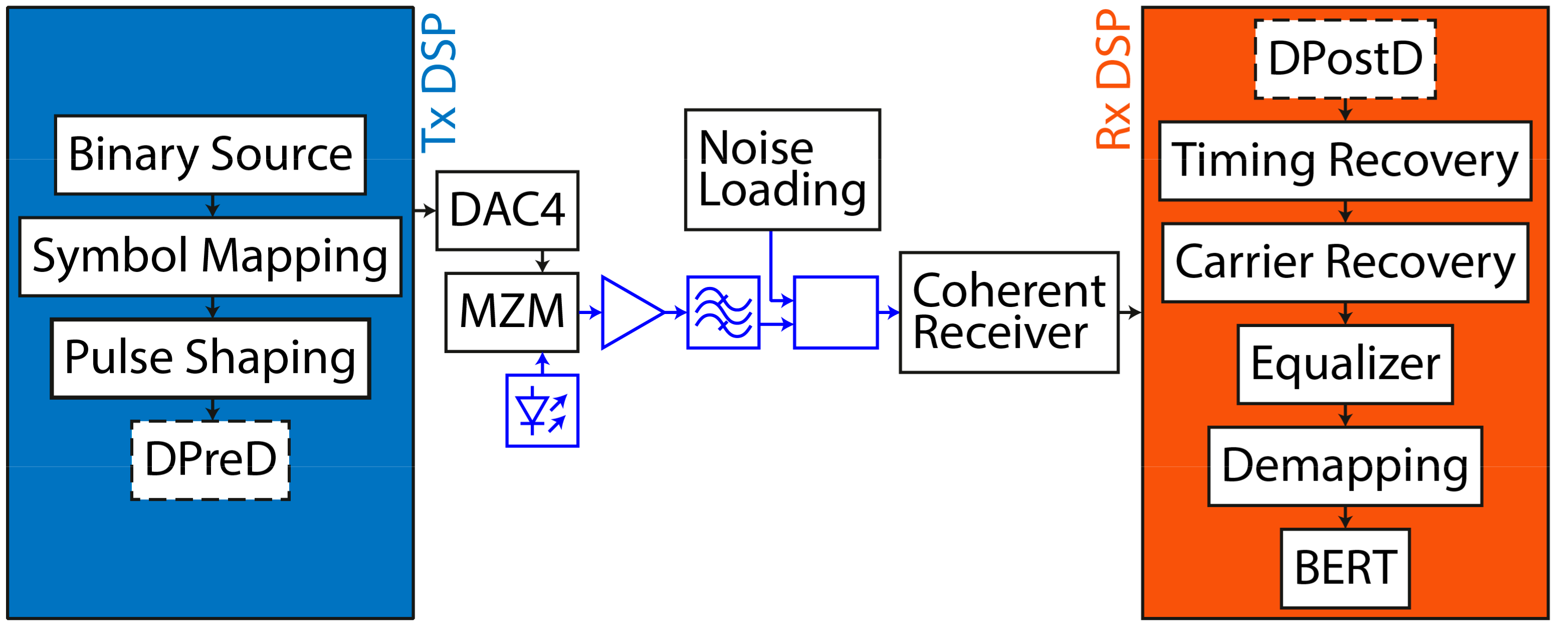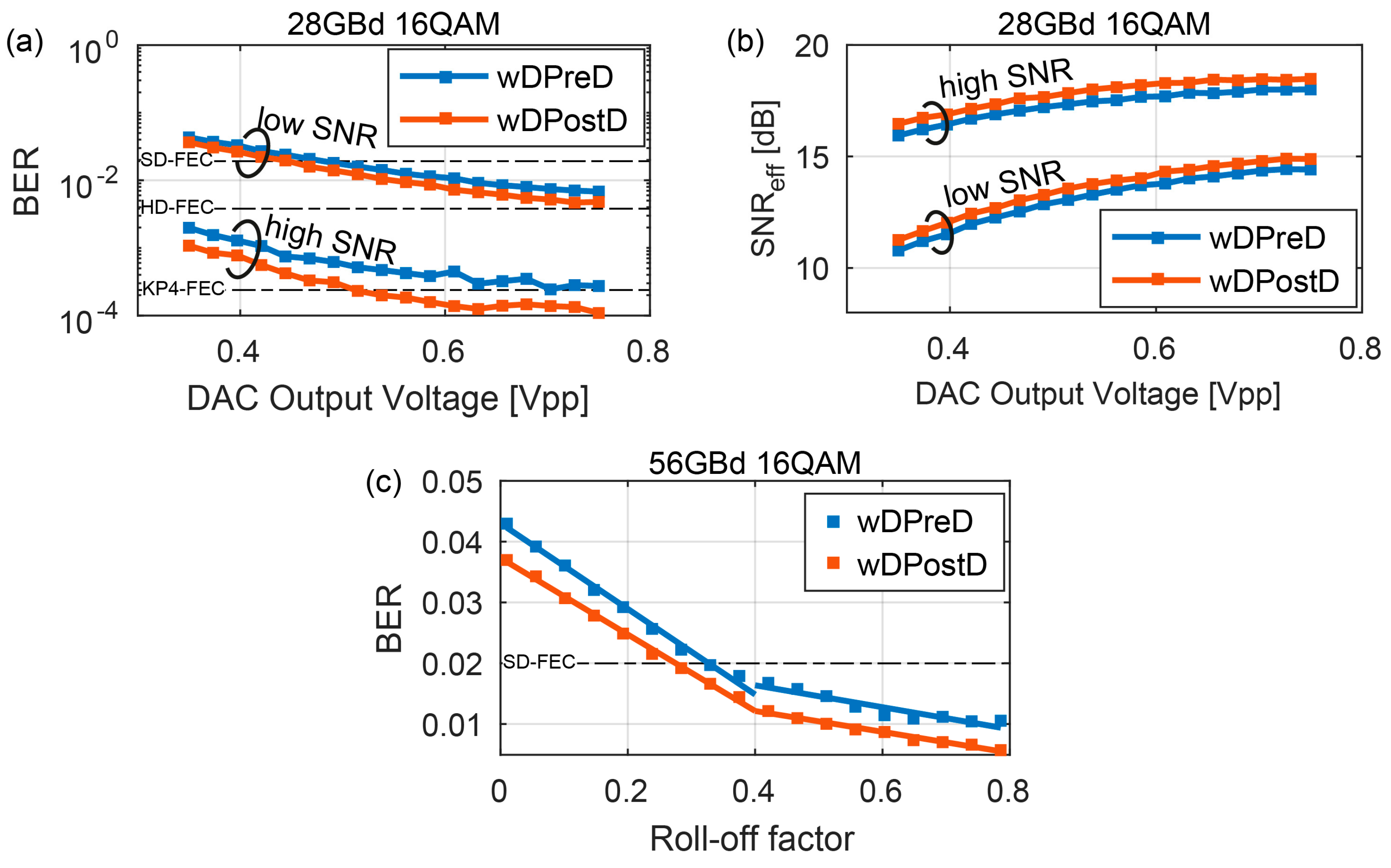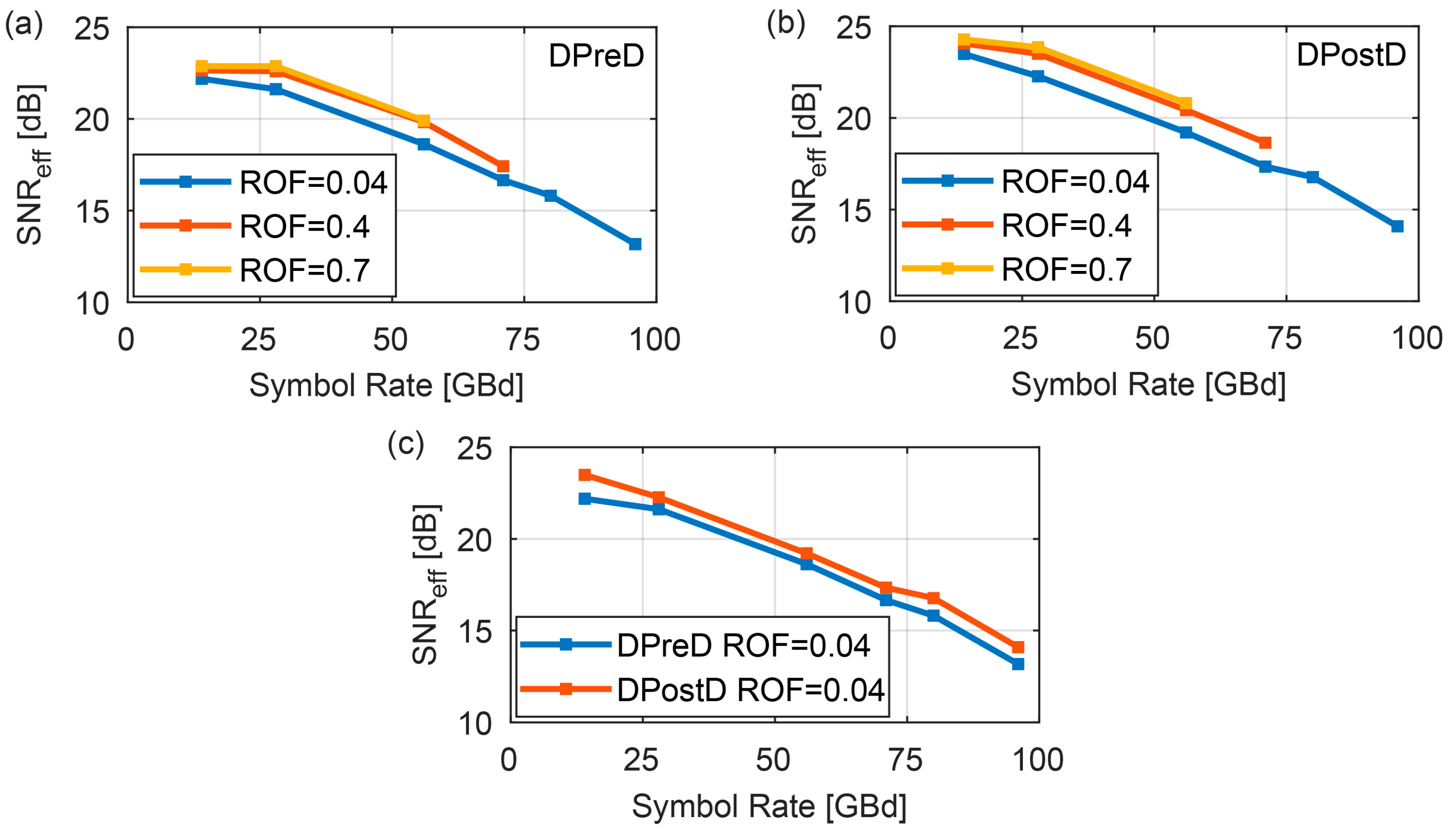Optical Transmitters without Driver Amplifiers—Optimal Operation Conditions
Abstract
:1. Introduction
2. Influence of Pulse Shape on the Electrical Eye-Opening
3. Investigation of the Effect of Clipping on the Electrical Eye-Opening
4. Influence of DPreD on the Electrical Eye-Opening
5. Measurements
6. Conclusions
Author Contributions
Funding
Acknowledgments
Conflicts of Interest
References
- Miller, D.A.B. Attojoule optoelectronics for low-energy information processing and communications. J. Lightw. Technol. 2017, 35, 346–396. [Google Scholar] [CrossRef]
- Fujisawa, T.; Kanazawa, S.; Takahata, K.; Kobayashi, W.; Tadokoro, T.; Ishii, H.; Kano, F. 13-μm, 4 × 25-gbit/s, eadfb laser array module with large-output-power and low-driving-voltage for energy-efficient 100 gbe transmitter. Opt. Express 2011, 20, 614. [Google Scholar] [CrossRef] [PubMed]
- Kataoka, T.; Miyamoto, Y.; Hagimoto, K.; Wakita, K.; Kotaka, I. Ultrahigh-speed driverless mqw intensity modulator, and 20 gbit/s, 100 km transmission experiments. Electron. Lett. 1992, 28, 897–898. [Google Scholar] [CrossRef]
- Loi, K.K.; Shen, L.; Wieder, H.H.; Chang, W.S.C. Novel high-frequency electroabsorption multiple-quantum-well waveguide modulator operating at 1.3 μm on gaas substrates. Optoelectron. Integr. Circ. 1997. [Google Scholar] [CrossRef]
- Wang, L.; Hu, R.; Li, M.; Qiu, Y.; Chen, D.; Xiao, X.; Li, Z.; Yu, Y.; Yu, J.; Yang, Q.; et al. Transmission of 24-Gb/s PAM-4 over 150-km SSMF using a driverless silicon microring modulator. In Proceedings of the Asia Communications and Photonics Conference 2014, Shanghai, China, 11–14 November 2014. [Google Scholar]
- Ackerman, E.; Betts, G.; Burns, W.; Prince, J.; Regan, M.; Roussell, H.; Cox, C. Low noise figure, wide bandwidth analog optical link. In Proceedings of the 2005 International Topical Meeting on Microwave Photonics, Seoul, Korea, 14 October 2005; pp. 325–328. [Google Scholar]
- Cox, C.H.; Ackerman, E.I.; Betts, G.E.; Prince, J.L. Limits on the performance of RF-over-fiber links and their impact on device design. IEEE Trans. Microw. Theory Tech. 2006, 54, 906–920. [Google Scholar] [CrossRef]
- Zhou, W.; Okusaga, O.; Nelson, C.; Howe, D.; Carter, G. 10 ghz dual loop opto-electronic oscillator without rf-amplifiers. In Proceedings of the Optoelectronic Devices, San Jose, CA, USA, 19–24 January 2008. [Google Scholar] [CrossRef]
- Shastri, A.; Webster, M.; Jeans, G.; Metz, P.; Sunder, S.; Chattin, B.; Dama, B.; Shastri, K. Experimental demonstration of ultra-low-power single polarization 56 Gb/s QAM-16 generation without DAC using CMOS photonics. In Proceedings of the 2014 The European Conference on Optical Communication (ECOC), Cannes, France, 21–25 September 2014; pp. 1–3. [Google Scholar]
- Wolf, S.; Lauermann, M.; Schindler, P.; Ronniger, G.; Geistert, K.; Palmer, R.; Kober, S.; Bogaerts, W.; Leuthold, J.; Freude, W.; Koos, C. Dac-less amplifier-less generation and transmission of qam signals using sub-volt silicon-organic hybrid modulators. J. Light. Technol. 2015, 33, 1425–1432. [Google Scholar] [CrossRef]
- Fujisawa, T.; Kanazawa, S.; Takahata, K.; Kobayashi, W.; Tadokoro, T.; Ishii, H.; Kano, F. Large-Output-Power, Ultralow-Driving-Voltage (0.5 Vpp) Operation of 1.3-um, 4 × 25 G, EADFB laser array for driverless 100 Gbe transmitter. In Proceedings of the European Conference on Optical Communication 2011, Geneva, Switzerland, 18–22 September 2011. [Google Scholar]
- Palmer, R.; Alloatti, L.; Korn, D.; Schindler, P.C.; Baier, M.; Bolten, J.; Wahlbrink, T.; Waldow, M.; Dinu, R.; Freude, W.; et al. Low power mach-zehnder modulator in silicon-organic hybrid technology. IEEE Photonics Technol. Lett. 2013, 25, 1226–1229. [Google Scholar] [CrossRef]
- Timurdogan, E.; Sorace-Agaskar, C.M.; Sun, J.; Hosseini, E.S.; Biberman, A.; Watts, M.R. An ultralow power athermal silicon modulator. Nat. Commun. 2014, 5, 4008. [Google Scholar] [CrossRef] [PubMed]
- Koeber, S.; Palmer, R.; Lauermann, M.; Heni, W.; Elder, D.L.; Korn, D.; Woessner, M.; Alloatti, L.; Koenig, S.; Schindler, P.C.; et al. Femtojoule electro-optic modulation using a silicon–organic hybrid device. Light. Sci. Appl. 2015, 4, e255. [Google Scholar] [CrossRef]
- Nozaki, K.; Shakoor, A.; Matsuo, S.; Fuji, T.; Takeda, K.; Shinya, A.; Kuramochi, A.; Notomi, M. Ultralow-energy electro-absorption modulator consisting of InGaAsP-embedded photonic-crystal waveguide. APL Photonics 2017, 2, 056105. [Google Scholar] [CrossRef]
- Baeuerle, B.; Hoessbacher, C.; Heni, W.; Fedoryshyn, Y.; Josten, A.; Haffner, C.; Watanabe, T.; Elder, D.L.; Dalton, L.R.; Leuthold, J. Driver-less Sub-1 Vpp-operation of a Plasmonic-organic hybrid modulator at 100 GBd NRZ. In Proceedings of the 2018 Optical Fiber Communications Conference and Exposition (OFC), San Diego, CA, USA, 11–15 March 2018. [Google Scholar]
- Sowailem, M.Y.S.; Hoang, T.M.; Morsy-Osman, M.; Chagnon, M.; Patel, D.; Paquet, S.; Paquet, C.; Woods, I.; Liboiron-Ladouceur, O.; Plant, D.V. 400-G single carrier 500-km transmission with an InP dual polarization IQ modulator. IEEE Photonics Technol. Lett. 2016, 28, 1213–1216. [Google Scholar] [CrossRef]
- Bülow, H.; Buchali, F.; Klekamp, A. Electronic dispersion compensation. J. Lightw. Technol. 2008, 26, 158–167. [Google Scholar] [CrossRef]
- Sowailem, M.Y.S.; Hoang, T.M.; Morsy-Osman, M.; Chagnon, M.; Qiu, M.; Paquet, S.; Paquet, C.; Woods, I.; Liboiron-Ladouceur, O.; Plant, D.V. Impact of chromatic dispersion compensation in single carrier two-dimensional stokes vector direct detection system. IEEE Photonics J. 2017, 9, 1–10. [Google Scholar] [CrossRef]
- Zhou, X.; Huo, J.; Zhong, K.; Khan, F.N.; Gui, T.; Zhang, H.; Tu, J.; Yuan, J.; Long, K.; Yu, C.; et al. Single channel 50 Gbit/s transmission over 40 km SSMF without optical amplification and in-line dispersion compensation using a single-end PD-based PDM-SSB-DMT system. IEEE Photonics J. 2017, 9, 1–11. [Google Scholar] [CrossRef]
- Mestdagh, D.J.G.; Spruyt, P.; Biran, B. Analysis of clipping effect in DMT-based ADSL systems. In Proceedings of the 1994 International Conference on Communications, ICC/SUPERCOMM/ICC ’94, Conference Record, Serving Humanity Through Communications, New Orleans, LA, USA, 1–5 May 1994. [Google Scholar]
- Tellado, J. Mutlicarrier modulation with low PAR: Applications to DSL and Wireless, 1st ed.; Kluwer Academic Publishers: Dordrecht, The Netherlands, 2002; ISBN 0-7923-7988-8. [Google Scholar]
- Armstrong, J. OFDM for Optical Communications. J. Lightw. Technol. 2009, 27, 189–204. [Google Scholar] [CrossRef]
- Hwang, T.; Yang, C.Y.; Wu, G.; Li, S.; Li, G.Y. OFDM and its wireless applications: A survey. IEEE Trans. Veh. Technol. 2009, 58, 1673–1694. [Google Scholar] [CrossRef]
- Lim, D.W.; Heo, S.J.; No, J.S. An Overview of peak-to-average power ratio reduction schemes for OFDM signals. J. Commun. Netw. 2009, 11, 229–239. [Google Scholar] [CrossRef]
- Shieh, W.; Djordjevic, I. OFDM for Optical Communications; Academic Press: Burlington, MA, USA, 2009. [Google Scholar]
- Randel, S.; Breyer, F.; Lee, S.C.J.; Walewski, J.W. Advanced modulation schemes for short-range optical communications. IEEE J. Sel. Top. Quantum Electron. 2010, 16, 1280–1289. [Google Scholar] [CrossRef]
- Fludger, C.R.S.; Duthel, T.; Hermann, P.; Kupfer, T. Low cost transmitter self-calibration of time delay and frequency response for high baud-rate QAM transceivers. In Proceedings of the Optical Fiber Communication Conference 2017, Los Angeles, CA, USA, 19–23 March 2017. [Google Scholar]
- Fludger, C.R.; Vercelli, E.S.; Marenco, G.; Torre, A.D.; Duthel, T.; Kupfer, T. 1Tb/s real-time 4 × 40 Gbaud DP-16QAM superchannel using CFP2-ACO pluggables over 625 km of standard fibre. In Proceedings of the Optical Fiber Communication Conference 2016, Anaheim, CA, USA, 20–22 March 2016. [Google Scholar]
- Juan, Q.; Mao, B.; Gonzalez, N.; Binh, N.; Stojanovic, N. Generation of 28 GBaud and 32 GBaud PDM-Nyquist-QPSK by a DAC with 11.3 GHz analog bandwidth. In Proceedings of the Optical Fiber Communication Conference 2013, Anaheim, CA, USA, 17–21 March 2013. [Google Scholar]
- Buchali, F.; Klekamp, A.; Schmalen, L.; Drenski, T. Implementation of 64QAM at 42.66 GBaud using 1.5 samples per symbol DAC and demonstration of up to 300 km fiber transmission. In Proceedings of the Optical Fiber Communication Conference 2014, San Francisco, CA, USA, 9–13 March 2014. [Google Scholar]
- Rafique, D.; Napoli, A.; Calabro, S.; Spinnler, B. Digital preemphasis in optical communication systems: On the dac requirements for terabit transmission applications. J. Light. Technol. 2014, 32, 3247–3256. [Google Scholar] [CrossRef]
- Chagnon, M.; Morsy-Osman, M.; Poulin, M.; Paquet, C.; Lessard, S.; Plant, D.V. Experimental parametric study of a silicon photonic modulator enabled 112-gb/s pam transmission system with a dac and adc. J. Light. Technol. 2015, 33, 1380–1387. [Google Scholar] [CrossRef]
- Napoli, A.; Mezghanni, M.M.; Rahman, T.; Rafique, D.; Palmer, R.; Spinnler, B.; Calabrò, S.; Castro, C.; Kuschnerov, M.; Bohn, M. Digital compensation of bandwidth limitations for high-speed DACs and ADCs. J. Lightw. Technol. 2016, 34, 3053–3064. [Google Scholar] [CrossRef]
- Khanna, G.; Spinnler, B.; Calabro, S.; De Man, E.; Hanik, N. A robust adaptive pre-distortion method for optical communication transmitters. IEEE Photonics Technol. Lett. 2016, 28, 752–755. [Google Scholar] [CrossRef]
- Khanna, G.; Rahman, T.; Man, E.D.; Riccardi, E.; Pagano, A.; Piat, A.C.; Calabro, S.; Spinnler, B.; Rafique, D.; Feiste, U.; et al. Single-carrier 400 g 64qam and 128qam dwdm field trial transmission over metro legacy links. IEEE Photonics Technol. Lett. 2017, 29, 189–192. [Google Scholar] [CrossRef]
- Khanna, G.; Spinnler, B.; Calabro, S.; de Man, E.; Chen, Y.; Hanik, N. Adaptive transmitter pre-distortion using feedback from the far-end receiver. IEEE Photonics Technol. Let. 2018, 30, 223–226. [Google Scholar] [CrossRef]
- Changsoo, E.; Powers, E.J. A new volterra predistorter based on the indirect learning architecture. IEEE Trans. Signal Process. 1997, 45, 223–227. [Google Scholar] [CrossRef]
- Guiomar, F.P.; Pinto, A.N. Simplified volterra series nonlinear equalizer for polarization-multiplexed coherent optical systems. J. Lightw. Technol. 2013, 31, 3879–3891. [Google Scholar] [CrossRef]
- Berenguer, P.W.; Nolle, M.; Molle, L.; Raman, T.; Napoli, A.; Schubert, C.; Fischer, J.K. Nonlinear digital pre-distortion of transmitter components. J. Lightw. Technol. 2016, 34, 1739–1745. [Google Scholar] [CrossRef]
- Jia, Z.; Chien, H.-C.; Cai, Y.; Yu, J.; Zhu, B.; Ge, C.; Wang, T.; Shi, S.; Wang, H.; Xia, Y.; et al. Experimental demonstration of PDM-32QAM single-carrier 400G over 1200-km transmission enabled by training-assisted pre-equalization and look-up table. In Proceedings of the 2016 Optical Fiber Communication Conference (OFC), Anaheim, CA, USA, 20–24 March 2016. [Google Scholar]
- Junwen, Z.; Yu, J.; Chien, H.-C. Advanced Algorithm for high-baud rate signal generation and detection. In Proceedings of the Optical Fiber Communication Conference 2017, Los Angeles, CA, USA, 19–23 March 2017. [Google Scholar]
- Napoli, A.; Mezghanni, M.M.; Calabrò, S.; Palmer, R.; Saathoff, G.; Spinnler, B. Digital predistortion techniques for finite extinction ratio IQ mach–zehnder modulators. J. Lightw. Technol. 2017, 35, 4289–4296. [Google Scholar] [CrossRef]
- Yamazaki, H.; Takahashi, H.; Goh, T.; Hashizume, Y.; Yamada, T.; Mino, S.; Kawakami, H.; Miyamoto, Y. Optical modulator with a near-linear field response. J. Lightw. Technol. 2016, 34, 3796–3802. [Google Scholar] [CrossRef]
- Josten, A.; Baeuerle, B.; Heni, W.; Leuthold, J. Digital post-distortion for cost-efficient driverless optical transmitters. In Proceedings of the Signal Processing in Photonic Communications 2018, Zurich, Switzerland, 2–5 July 2018. [Google Scholar]
- Gnauck, A.H.; Raybon, G.; Chandrasekhar, S.; Leuthold, J.; Doerr, C.; Stulz, L.; Agarwal, A.; Banerjee, S.; Grosz, D.; Hunsche, S.; et al. 2.5 Tb/s (64 × 42.7 Gb/s) Transmission over 40 × 100 km NZDSF using RZ-DPSK formatand all-raman-amplified spans. In Proceedings of the Optical Fiber Communications Conference, Anaheim, CA, USA, 17 March 2002. [Google Scholar]
- Winzer, P.J.; Dorrer, C.; Essiambre, R.-J.; Kang, I. Chirped return-to-zero modulation by imbalanced pulse carver driving signals. IEEE Photonics Technol. Lett. 2004, 16, 1379–1381. [Google Scholar] [CrossRef]
- Gnauck, A.H.; Winzer, P.J. Optical Phase-Shift-Keyed Transmission. J. Lightw. Technol. 2005, 23, 115. [Google Scholar]
- Kang, I.; Mollenauer, L.F. Method and Apparatus for Synchronizing a Pulse Carver and a Data Modulator for Optical Telecommunication. U.S. Patent 7,209,669 B2, 24 April 2007. [Google Scholar]
- Behrens, C.; Makovejs, S.; Killey, R.I.; Savory, S.J.; Chen, M.; Bayvel, P. Pulse-shaping versus digital backpropagation in 224gbit/s pdm-16qam transmission. Opt. Express 2011, 19, 12879. [Google Scholar] [CrossRef] [PubMed]
- Hirooka, T.; Ruan, P.; Guan, P.; Nakazawa, M. Highly dispersion-tolerant 160 Gbaud optical nyquist pulse tdm transmission over 525 km. Opt. Express 2012, 20, 15001. [Google Scholar] [CrossRef] [PubMed]
- Soto, M.A.; Alem, M.; Amin Shoaie, M.; Vedadi, A.; Brès, C.-S.; Thévenaz, L.; Schneider, T. Optical sinc-shaped Nyquist pulses of exceptional quality. Nat. Commun. 2013, 4, 2898. [Google Scholar] [CrossRef] [PubMed]
- Proakis, J.G.; Salehi, M. Digital Communications, 5th ed.; McGraw-Hill: New York, NY, USA, 2008. [Google Scholar]
- Chatelain, B.; Gagnon, F. Peak-to-average power ratio and intersymbol interference reduction by Nyquist pulse optimization. In Proceedings of the IEEE 60th Vehicular Technology Conference, 2004, VTC2004-Fall, Los Angeles, CA, USA, 26–29 September 2004; pp. 954–958. [Google Scholar]
- Jansen, S.L.; Morita, I.; Schenk, T.C.W.; Takeda, N.; Tanada, H. Coherent Optical 25.8-Gb/s OFDM transmission over 4160-km SSMF. J. Lightw. Technol. 2008, 26, 6–15. [Google Scholar] [CrossRef]
- Buchali, F.; Idler, W.; Rastegardoost, N.; Drenski, T.; Ward, R.; Zhao, L. Preemphased prime frequency multicarrier bases ENOB assessment and its application for optimizing a dual-carrier 1-Tb/s QAM transmitter. In Proceedings of the 2016 Optical Fiber Communications Conference and Exhibition (OFC), Anaheim, CA, USA, 20–24 March 2016. [Google Scholar]
- Nikookar, H.; Lidsheim, K.S. Random phase updating algorithm for ofdm transmission with low papr. IEEE Trans. Broadcast. 2002, 48, 123–128. [Google Scholar] [CrossRef]
- Schuh, K.; Buchali, F.; Idler, W.; Hu, Q.; Templ, W.; Bielik, A.; Altenhain, L.; Langenhagen, H.; Rupeter, J.; Duemler, U.; et al. 100 GSa/s BiCMOS DAC supporting 400 Gb/s dual channel transmission. In Proceedings of the ECOC 2016; 42nd European Conference on Optical Communication, Dusseldorf, Germany, 18–22 September 2016. [Google Scholar]
- Josten, A.; Baeuerle, B.; Dornbierer, E.; Boesser, J.; Hillerkuss, D.; Leuthold, J. Modified godard timing recovery for non integer oversampling receivers. Appl. Sci. 2017, 7, 655. [Google Scholar] [CrossRef]







© 2018 by the authors. Licensee MDPI, Basel, Switzerland. This article is an open access article distributed under the terms and conditions of the Creative Commons Attribution (CC BY) license (http://creativecommons.org/licenses/by/4.0/).
Share and Cite
Josten, A.; Baeuerle, B.; Bonjour, R.; Heni, W.; Leuthold, J. Optical Transmitters without Driver Amplifiers—Optimal Operation Conditions. Appl. Sci. 2018, 8, 1652. https://doi.org/10.3390/app8091652
Josten A, Baeuerle B, Bonjour R, Heni W, Leuthold J. Optical Transmitters without Driver Amplifiers—Optimal Operation Conditions. Applied Sciences. 2018; 8(9):1652. https://doi.org/10.3390/app8091652
Chicago/Turabian StyleJosten, Arne, Benedikt Baeuerle, Romain Bonjour, Wolfgang Heni, and Juerg Leuthold. 2018. "Optical Transmitters without Driver Amplifiers—Optimal Operation Conditions" Applied Sciences 8, no. 9: 1652. https://doi.org/10.3390/app8091652
APA StyleJosten, A., Baeuerle, B., Bonjour, R., Heni, W., & Leuthold, J. (2018). Optical Transmitters without Driver Amplifiers—Optimal Operation Conditions. Applied Sciences, 8(9), 1652. https://doi.org/10.3390/app8091652




